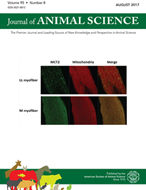-
Views
-
Cite
Cite
J. J. Wagner, T. E. Engle, T. C. Bryant, The effect of rumen degradable and rumen undegradable intake protein on feedlot performance and carcass merit in heavy yearling steers, Journal of Animal Science, Volume 88, Issue 3, March 2010, Pages 1073–1081, https://doi.org/10.2527/jas.2009-2111
Close - Share Icon Share
ABSTRACT
A total of 432 crossbred yearling steers (395 kg ± 6.35) were used in a randomized block experiment to study the effects of rumen degradable intake protein (DIP) and rumen undegradable intake protein (UIP) concentration on feedlot performance and carcass merit. The 6 dietary treatments used for this study included 1) a 10.5% CP diet with 5.1% UIP and 5.4% DIP (DIP5); 2) an 11.5% CP diet with 5.1% UIP and 6.4% DIP (DIP6); 3) a 12.5% CP diet with 5.1% UIP and 7.4% DIP (DIP7); 4) a 13.5% CP diet with 5.1% UIP and 8.4% DIP (DIP8); 5) a 14.5% CP diet with 5.1% UIP and 9.4% DIP (DIP9); and 6) a 14.5% CP diet with 6.1% UIP and 8.4% DIP with the additional UIP provided by corn gluten meal. There was a linear increase in final BW and ADG and a trend for a linear increase in DMI associated with increasing DIP concentration within the 5.1% UIP treatments. Feed efficiency and NE recovered from the diet were not influenced by dietary DIP concentration. As dietary DIP concentration increased, carcass fat depth and average yield grade increased linearly and the percentage of yield grade 1 and 2 carcasses decreased linearly. Dietary UIP treatment had no effect on final BW, ADG, DMI, G:F, and calculated NE recovery. For the 14.5% CP diets, marbling score tended to be reduced for steers fed 6.1% UIP as compared with 5.1% UIP. The remaining carcass traits were not affected by dietary UIP. The results of this study show that the DIP requirement in the finishing diet for heavy yearling steers fed steam-flaked corn is greater than 7.4% of dietary DM but likely is not more than 8.4% of dietary DM when dietary UIP is approximately 5.1% of dietary DM. Increasing UIP above 5.1% of dietary DM did not improve feedlot performance or HCW. Expressed on a CP basis, it appears as though the requirement for CP for heavy yearling steers fed steam-flaked corn-based finishing diets is 13.5% of DM, with approximately 62% of CP from DIP.





